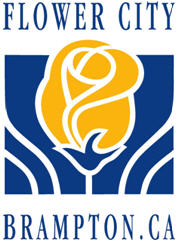
March General
Meeting
|
|
March 10th 2009
Us -Too! Brampton General Meeting
"Integrating Technology for Radiotherapy
in Prostate Cancer" Dr. Peter Chung
Dr. Chung has presented twice before at
our meetings. We are very grateful
to Dr. Peter Chung for his latest
high tech. presentation and keeping
us abreast of the 'State-of-the Art' technology in Radiotherapy
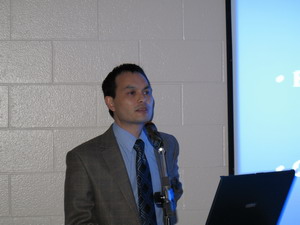
In his third visit in as many years, Dr. Chung presented
a review of the "state-of-the-art" in
Radiotherapy that has evolved over the last few years. He discussed the
levels of risk in
prostate cancer as related to the PSA level and Gleason score of an
individual and the best
approaches in Radiotherapy to benefit patients at each risk level. For low
risk patients
Brachytherapy or External Beam Radiotherapy would be indicated. For
intermediate risk
patients Brachytherapy may be combined with External Beam Radiotherapy.
For high risk
patients External Beam Radiotherapy may be combined with Hormone Therapy.
Dr. Chung reviewed study results that indicated that higher doses of
focused Radiotherapy
were helping to bring about better long term outcomes for patients in
intermediate to high risk
categories. To bring about this result without increasing side effects is
a long term goal of
Radiotherapy. Several techniques have been developed in recent years to
increase the
precision and accuracy of the applied treatment while limiting the
exposure of surrounding
tissues. These techniques include: IMRT (Intensity Modulated Radiation
Therapy), IGRT
(Image Guided Radiation Therapy) and VMAT (Volumetric Modulated Arc
Therapy).
All of these techniques aim to deliver the dose as accurately as possible
and in the case of
VMAT in as little time as possible. They all make use of various imaging
aids including CAT
Scans, MRIís and Ultrasound Imaging to more accurately map the location of
the Prostate. In
addition gold markers are often used as additional visual aids in the
process.
MRIís can deliver better images in many cases than CAT Scans and have been
used more
frequently in the last 5 years. IV Contrast Materials can also be used to
in some cases indicate
the actual position of some tumors within the Prostate. While the
treatment would still be
focused on the entire prostate gland, some additional dose could in theory
be delivered to the
site of the larger tumors. MRIís can also often clearly illustrate
instances where a tumor has
grown outside the prostate and this may also aid in determining the best
treatment plan.
Several techniques have also been developed to offset problems that occur
when the prostate
moves during treatment. In the past technicians would need to manually
adjust the equipment,
but now moving couches and adjusting MLCíc, ( Multi-Leaf Collimators ),
have helped
automate the procedure. VMAT in particular uses a moving arc treatment in
combination with
a automatically adjusting MLC to apply the treatment in as little a 5
minutes. The shortened
treatment period also lessens the possibility that the prostate will move
during treatment.
In the future expanding miniature GPS technology may even be linked to the
equipment to
deliver a highly accurate dose even if the prostate moves significantly
during treatment.
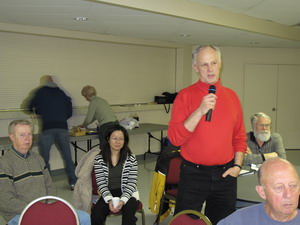
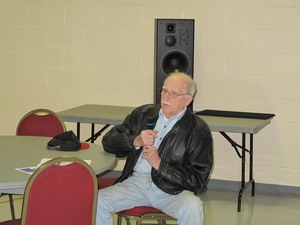
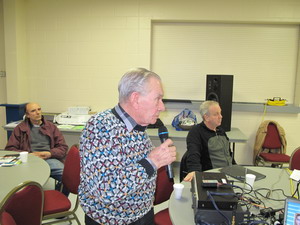

Following his talk Dr. Peter Chung undertook questions
and answers from the audience
and it turned out to be a very interactive session.
The talk was attended by an audience of around 40 members, spouses and
guests including
some newly diagnosed attending at our meeting for the first time.
We are pleased to offer the complete AUDIO
recordings and SLIDES downloads
of Dr. Peter Chung's talk. Please visit the links below.




ABOUT Dr. Peter Chung
Dr. Peter Chung is a Staff Radiation Oncologist Princess Margaret
Hospital and
Assistant Professor, Dept. of Radiation Oncology at the University of
Toronto.
He Undertook medical training in the U. K., undergraduate studies at the
University of Sheffield and Post-Graduate training in internal medicine.
He Completed training in Clinical Oncology at the University of
Birmingham.
He arrived in Canada as a Clinical Fellow in Radiation Oncology at
Princess Margaret Hospital and was invited to stay on in
a permanent capacity.
AUDIO & SLIDES DOWNLOADS
AUDIO:
Track 01:
Integrating
Technology for Radiotherapy - Talk
Track 02:
Integrating
Technology for Radiotherapy - Q&A
SLIDES:
"Integrating Technology for Radiotherapy" - Presentation Slides
PROSTATE CANCER AWARENESS!
Prostate Cancer Canada Network - Brampton
∑
Tel: 905- 453-3038 ∑ Fax: 905-840-9474 ∑ Email: info@pccnbrampton.com

